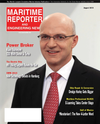
Page 3rd Cover: of Maritime Reporter Magazine (August 2010)
The Electric Ship
Read this page in Pdf, Flash or Html5 edition of August 2010 Maritime Reporter Magazine
FPSO vessels and semi-submersible FPS platforms are the candidates of choice for marginal projects. An example of a mar- ginal project made viable through the use of an FPS is Statoil’s Glitne project in the
Norwegian sector of the North Sea. The field, in WD 109m, was thought to have reserves of just 32 mmbbl oil and 10 Bcf gas. A leased FPSO – the Petrojarl I – was selected for the project. Developed via four subsea production wells and one injector, Glitne is the smallest field on the
Norwegian shelf ever brought into pro- duction on a stand-alone basis.
Innovations
Given the high financial stakes involved in FPS-led projects, there is a natural ten- dency for operators to play it safe and stick with proven FPS designs rather than investing in a promising but untried con- cept. Unfortunately – from the point of view of the concept originators, at least – this tendency may actually be reinforced in these key areas of deepwater and mar- ginal projects where, because of their rel- atively high risks and/or limited rewards, there is even less room for error. Hence, it is usually the smaller, independent op- erators (who are by default risk-taking entrepreneurs) that select an innovative design rather than the larger multi-na- tional operators.
To date, the majority of FPS develop- ments worldwide have been either semi- submersible FPSs, based on converted semi-submersible drilling rigs, or oil tankers converted into FPSOs. In techni- cal terms this is more evolutionary than innovative, and evolution generally car- ries less business risk than innovation. It is only relatively recently that other more innovative concepts – notably TLPs and spars – have become more common.
Once a new design gets accepted and suc- cessfully deployed, uptake of the idea can be fairly swift – as evidenced by the wave of spar projects currently moving forward in the GoM. The danger for concept orig- inators is that the acceptance and deploy- ment of a rival FPS solution may result in the exclusion of other concepts target- ing the same niche market (e.g. marginal fields off West Africa) on account of op- erators’ understandable preference for field-proven technology. More detailed analysis of the global Floating Produc- tion market is available in Douglas-West- wood’s, ‘World Floating Production
Market Report 2010-2014.’
August 2010 www.marinelink.com 27
Type
Source: The World Floating Production Market Report 2010- 2014, Douglas-Westwood
The Authors
Established in 1990, Douglas-West- wood is an independent employee- owned company and the leading provider of business research & analy- sis, strategy and commercial due dili- gence on the global energy services sectors. Further information is avail- able at www.dw-1.com. Contact:
Email: [email protected]
Tel: +44 (0) 1227 780999

 26
26

 4th Cover
4th Cover
